tags: bird behavior, emotional lives of animals, ornithology, birds, avian, photoessay
The bird calls out after realising that his (her?) mate is dead
Image: Wilson Hsu, AbuNawaf.com [larger view].
There are many inexplicable and tragic events in nature, yet few are captured on film. Here is an interesting series of photographs depicting a pair of swallows, Hirundo rustica (known as the Barn Swallow in the United States). In this series of images, we watch the story that unfolds after one of the birds was fatally injured, yet the bird's mate remains nearby, delivering food or water and keeping its dying companion company.
In this image, we see the healthy bird as it "mantles" (covers with its wings) its injured, but still living, companion;
Image: Wilson Hsu, AbuNawaf.com [larger view].
The healthy bird brings food (water?) to its injured companion, caring for it as if the dying bird was one of its chicks;
Image: Wilson Hsu, AbuNawaf.com [larger view].
Despite the healthy bird's attentions, its injured companion dies. The healthy bird apparently attempts to rouse its dead companion;
Image: Wilson Hsu, AbuNawaf.com [larger view].
Another look at the obviously distressed bird as it tries to revive its dead and unresponsive companion;
Image: Wilson Hsu, AbuNawaf.com [larger view].
Okay, I am not one to anthropomorphize animals since I am completely unconvinced that most people are capable of experiencing deep or complex emotions, however, this image really makes me wonder what this bird is doing? Is this bird calling its dead companion, hoping the bird will respond to its voice? Or is this bird .. grieving? I mean, what is grieving among humans, except for the deceased's living companions calling out to their lost friend, and celebrating their friendship by reliving their experiences with their dead companion?
Image: Wilson Hsu, AbuNawaf.com [larger view].
Apparently, the healthy bird remained by the side of its fallen companion for an unknown period of time. What was the bird accomplishing by doing this? Was it guarding its dead companion? Waiting for the dead bird to finally rouse and follow him (her) into the skies?
Image: Wilson Hsu, AbuNawaf.com [larger view].
I am curious to know what you think about this series of images. Certainly, it is heartbreaking to view them through the lense of human emotions, but I do wonder about the emotional lives of animals, especially highly social and intellectually complex animals, such as birds. It is doubtful that birds think about (or obsess about) death as humans do, but does that mean they are less affected by death when it happens to a close companion?
I guess this is one of the many great mysteries that we will never really know the answer to.

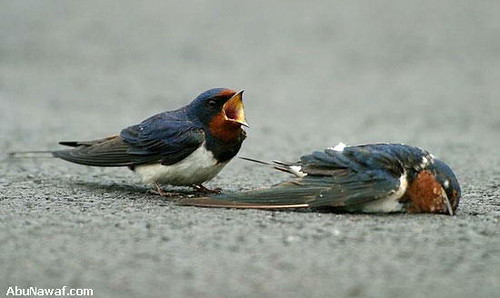
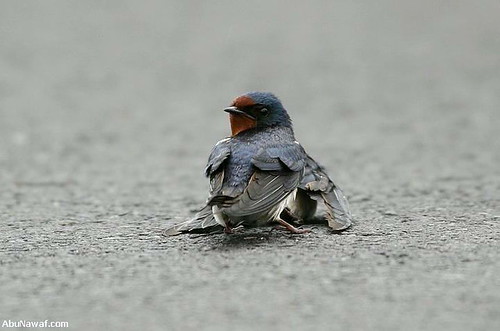
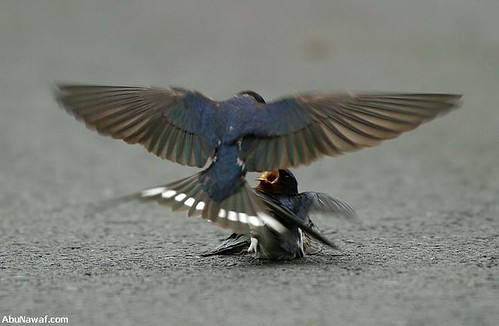
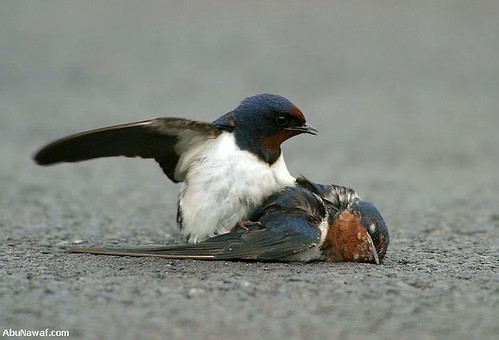

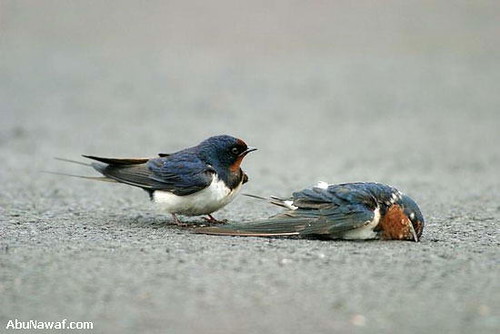
i received this comment in email;
This is perhaps one of the most emotionally affecting series of wildlife photos I have ever seen. It lends great strength to any and all who argue for the existence of a complex emotional life in non-human animals.
I'm not sure what species of bird this is, but the two birds look very similar. In many cases, the males and females look significantly different. So - I'm not certain that this is a Male/Female pair. That being said, it may not matter, as many animals form same-sex relationships. (That's something that many people aren't aware of - maybe if they were, the whole 'gay is unnatural thing' view not be so prevalent)
Can someone identify the species?
Sorry, I'm going to burst your bubble. Here are a couple of notes about this series of pictures, which was first pointed out to me (floating around the net) maybe 5 years ago:
- in the pictures where the injured swallow is dead, the live swallow is unmistakably doing what male swallows try to do to any female swallow who is temporarily handicapped or otherwise available. As a swallow expert delicately put it, he seems to be making the best of a bad situation.
- in the picture where the injured but still alive bird is looking over its shoulder at the oncoming male, the injured bird does not look to me to be happy about the approach.
- the injured/dead bird appears to be a first year bird, still with a juvenile outer primary, and so not sexually mature, not likely mated to anyone (and not necessarily even a female - male swallows are not picky).
I use this same series of pictures in an animal behavior class I teach, including the emotion laden commentary I clipped off the net years ago, explaining how one bird was trying to help its injured mate. Students respond the way several commenters have here. I do it in the first class to teach some lessons about how birds aren't little people in feathers, and how easy it is to misinterpret what's really going if you don't look carefully and come to your own conclusions. My only problem has been that if I break out the necrophiliac swallows on day one, how do I ever top that in the rest of the class?
here's the url to the taiwanese site where I originally saw these photos, and the set there is larger than what appears on this page:
http://www.dcview.com.tw/gallery/showmsg.asp?sre=2&msgid=271976
Surprising that the link still works....
Having bred many species of birds for the past 25 years, I've witnessed the mourning and sadness of long term pairs or cage mates who have lost their loved ones. So have I heard stories about how a parrot has died after their human keeper died. They can't cry or express themselves in human ways, but I do believe they mourn - some for a short time and others forever. The stories are touching.
fake
That's something that many people aren't aware of - maybe if they were, the whole 'gay is unnatural thing' view not be so prevalent)
you know, chris, i wondered about the possibility of necrophilia .. swallows tend to be horny little bastards .. but i was unable to tell precisely what was happening from the images. it makes a touching story the way i understood it to be, but it makes a much more realistic story the way you tell it.
thanks fr the link, too. i appreciate it.
Yes, I'm afraid I agree with Chris Hill and don't mind diagnosing a case of good old fashioned sex. The same behaviour has been documented for Mallards, with a lot less ambiguity.
I agree with Chris. Note also that the healthy Barn Swallow in the "mantling" photo actually is not mantling; its wings are folded against its own body. It's just the composition of the photo that's confusing.
Still, interesting, of course; just check out the list of more scholarly, better-documented interactions of this sort.
These are remarkable photos, but an emotional life among birds is a given, what with pair bonding, nest tending and feeding the young.
What startled me several years ago was the possibility among insects; in this case a pair of borer bees. Borer bees were making a nuisance of themselves just above the shed door, so I sprayed them and immediately dropped two about six inches apart on the wooden deck where they began their death throes. Walking away and returning a few moments later, I was surpised to see that one bee had crawled the distance to the other and seemed to embrace it, as they both expired.
The possibility of an emotional bond among individual bees seemed to be the only explanation.
I was discussing the California ballot propositions with a neighbor the other day as we watched our dogs play at a neighborhood park. I mentioned that I was going to be voting against most of the current batch, but I then remembered that I was planning to vote in favor of Proposition 2 (which would require the poultry industry to allow birds more room in their cages). My neighbor chuckled and responded that she liked animals, but in this case she couldn't see it as a big deal. "They're just food," she said.
I think we do damage to our own spiritual health when we view other living things as having significance only in terms of their utility for us. And I think it's just objectively wrong from a scientific standpoint. Anthropomorphizing might be objected to when it manifests itself as cute little talking animals with human features in Disney movies. But when someone accuses me of anthropomorphizing for speculating about the emotional experiences of non-human animals, especially animals that are equipped with similar neurological structures to those associated with emotional responses in humans, and that give every appearance of exhibiting equivalent, or at least very similar, emotional responses to those I experience, I think it says more about the failings of their own epistemology than of mine.
As an objective matter, anyone who believes in evolution believes that everything living is related to us. And I don't mean in some metaphysical sense; I mean it is literally the case that every living thing is an (admittedly very distantly removed) aunt or uncle or cousin. The mere fact that isolation and evolutionary pressures caused the descendants of our common ancestor to diverge into separate species does not, to my mind, erase the ethical obligation to consider the other being's experiences to be to some extent significant.
I think one of the best expressions of this was in that much-quoted passage by Henry Beston, from The Outermost House:
At its heart, the argument against anthropomorphizing seems to be this: That it is objectively wrong to try to project human emotions and experiences onto non-human animals. And I think that's a valid concern. Where I think the argument goes wrong is when people carve out too much of the human experience and classify it as being intrinsically human. A great deal of our human experience is actually shared with non-human organisms. True, they don't have some sort of inner dialog in which they use English to describe their feelings. But then, I'm not convinced that my own emotional responses have much to do with such an inner dialog. And from personal experience, I'm convinced that yellow labradors and peach-faced lovebirds, at least, experience fear, and joy, and sorrow. I don't need for them to be able to talk about it in a human language in order for it to be real.
I'd feel more comfortable making a similar judgment about the Eurasian barn swallows pictured in this photo essay if I had video of the event, rather than a few still photos. But based on those photos, I see every reason to believe, and no reason to dispute, that the surviving bird is exhibiting the same sort of emotional distress I would feel if I were present at the death of my own mate, an event I don't even want to imagine.
Ah. And having now read Chris Hill's comment above (which I hadn't done before posting the above comment), I'd have to back off the "every reason to believe, and no reason to dispute" language in my last paragraph. I'd stand by the rest, though.
I have kept birds (lovebirds) as pets, and I have no doubt that birds do experience emotions (and strong ones at that!) and can form extremely close bonds to other birds/people/etc. However, I have to agree with Chris on this one. This particular case seems to be of just a horny bird.
What worries me is that some people will generalize and think that any time anyone says something like what I just said above about my birds, that they are just misinterpreting what they have just seen. There are a lot of people who are extreme non-anthropomorphizers, and who seem to think that merely saying that animals experience emotions (ANY emotion) is wrong.
Chris Hill is right on, of course. Barn Swallows are, sadly, among the most frequent of roadkills in the late summer, and it's very common to see adult males come in and attempt copulation with the corpse. It's not "necrophilia" (come on now!), but the lack of movement seems to act as a releaser.
Great set of pictures, though.
Hi all,
I'm a little uncomfortable with some of the comments far above this on this list.
We can bring along our cultural baggage when we look at this. " Horney bastard" is not a swallow concept. Using those words can keep us from being scientific about what is happening. It may not always or ever be the case that a copulation attempt disproves the existence of mourning.
(I'm not saying this picture series does shows mourning, I tentatively go along with the debunkers here, but it pays to keep the skepticism chain going).
I also want to remind everyone not to always equate science with the debunking of anthropomorphism--it works both ways. Being an extremely old man, I can remember being told we were the only species to use tools. Now the list keeps growing.
A belief that it's unscientific to ascribe intelligence or emotions to animals leads humans to many real life, costly mistakes. The guy who thought he could fool mommy, (a dog) about where he buried her puppies and then got into legal trouble when she went right to the spot and dug them up is one example, but all the people who waste money on recorded predator noises and porceline owls is a more universal example.
We think dogs and cats are stupid because they don't see well, which would be similar to owls thinking we're idiots because we stumble around like idiots on a dark night.
Barn Swallows are unbelieveably high-strung. They usually nest near humans and work with humans, particularly human farmers, in a symbiotic way to protect there young from crow (or other avian predator) predation (in the process letting the farmer know when corvids are present. They are very high strung and excitable. They depend on the survival of their mate during this time, and if either bird perishes, the whole effort is likely to fail. If you want to gain respect for their mental skills, watch them keep track of 4 or 5 young and clumsy babies and all neighborhood predators as they all fledge. The adults will park, say, three in a safe place while they take 2 out on a training flight, and are able to keep track of the everybody and herd them all back to the nest night after night after fledging.
Just don't want anyone dissing Barn Swallows,
Thanks Ed Newbold Wildlife Artist Seattle, WA
Hi all,
I'm realizing I was way too understated--there is actaully a serious flaw in Chris Hill's analysis. He's assuming that the presence of copulation-attempts automatically disproves mourning.
What if copulation attempts are part of mourning (and part of the discovery process that the mate is dead). Just because we don't do it that way, doesn't mean they don't. Male swallows are always trying, why wouldn't they try even more urgently when confronted with the dying or death of their mate. That in no way should be seen as proof or even evidence that they don't mourn, or in this case that the bird in the photo series is not mourning. For that matter, the dying bird's rebuff wouldn't prove she doesn't welcome his presence. Our female often rebuffs our male but still they usually wind up sitting two or three inches apart on the wire all through the season.
In other words, this bird may be mourning or not. We don't know.
I've read of Tree Swallows going into a three day frump after losing a nestbox-war with House Sparrows. If that's true, certainly losing a mate is even more serious if it occurs into the breeding season, as the whole effort, perhaps for the entire year is surely lost. Knowing how upset Barn Swallows get at the threat of the loss of even one baby, it's kind of a stretch to think they wouldn't go into something like mourning after losing a mate.
Thanks, Ed Newbold Wildlife Artist Seattle WA
This is heartbreaking...
As a preteen living in the prairie part of western Minnesota, a friend and I were slingshot hunters. All small birds, squirrels and gophers were fair game.
I was a good shot and one day on the way to school I shot a male robin. The mate, within seconds, flew to the side of the dead bird and nudged it, fluttered around it and I felt was certainly concerned and perhaps grieving. The incident bothered me the rest of the day and 75 years later is still disturbing.
I am a biological scientist and generally criticaL of anthropomorphism but today that action can still be considered and interpreted to be a demonstration of concern and grief by the mate.
It seems to me that anthropomorphism is a perfectly reasonable approach to understanding animal behavior. We know that our intellects exceed those of animals, but we also know that this a recent evolutionary development. Emotions are much older and more deeply rooted in the older parts of the brain. Furthermore, I can't think of any selective pressure that would cause our emotional psychology to diverge from that of our non-human ancestors just because we got smarter. So unless/until we have evidence to the contrary, Occam's razor implies that the proper approach to understanding animal emotions should be to assume that they are analogous to our own. It is the contrary assumption, that humans are for some reason "special", that is unscientific.
Re Chris Hill's comment: can any of you bird people confirm that the living bird in the photos is in fact a male?
I found these photos and all the comments quite interesting. At first I was saddened by the photos and their description. But that just goes to show you how we believe everything we read. I will freely admit that I am guilty of anthropomorphism everyday! That said - did anyone think of the possibility of this being 2 females with one purposely trying to kill the other. . . or the other way around, 2 males. Perhaps the dying bird is an intruder to a happy nest. Just a few thoughts from a happy anthropomorphidite! (Is that a real word?? :))
Esta claro que los animales tienen mas "humanidad" que los mismos seres humanos.
No se comprende estos comportamientos en los animales, como tampoco se comprenden los comportamientos en los seres humanos de total desprecio a la propia vida como es el tema de los miles de abortos que se producen en el mundo todos los dias y nos pensamos en ello.
A eso se llama antihumanidad y deberiamos reflexionar ante esta muestra de cariño de dos animales.
Gracias por publicarlo.
Los animales que no pertenecen a nuestra especie son individuos que también tienen la capacidad de sufrir y el interés de disfrutar de su vida. Esta capacidad es la única caracterÃstica relevante para que un individuo sea considerado moralmente y respetado dado que indica que se puede ver afectado por nuestros actos. No existe ningún argumento mÃnimamente coherente que pueda establecer que sus intereses deban ser infravalorados por nuestra especie homo sapiens. El criterio de especie (especismo) es un criterio arbitrario, y por lo tanto injusto, asà como lo es el criterio de raza, sexo, inteligencia o nacionalidad.
http://respuestasveganas.blogspot.com/
This is absolutely heart breaking. Having had many pets of my own, it goes without saying that animals and birds experience emotions and sentiments just as deeply as tender hearted humans and much more than the callous ones among us.
FTR, here's a page by the photographer with further images from the series, and including english-language comments:
http://photo.net/photodb/photo?photo_id=2315290
One bird was killed by a truck, and was dead immediately. No feeding or bringing of water. The third image has a third bird in the foreground, the dead one is nearly hidden by the presumed mate sitting on the ground. You can see the tail behind the the white leg-part of the sitting swallow.
While the copulation attempt does seem clear, that does indeed not exclude some form of pain about the death. Barn swallows form couples for life, and there is no reason to assume that they do not have a special relationship. While human grief is likely to be different from barn swallow grief, the word does still not seem wrong, based on the events seen by the photographer.
No se comprende estos comportamientos en los animales, como tampoco se comprenden los comportamientos en los seres humanos de total desprecio a la propia vida como es el tema de los miles de abortos que se producen en el mundo todos los dias y nos pensamos en ello.
Today a flock of 6 barn swallsow were playing near our barn. They flew across a busy highway when one was hit by a car. All 6 were genuinely distressed and kept landing in the highway. I ran to see if the bird was alive (not) and put it on a white paper towel off the side of the road. Over thirty years of animal observation - these birds were clearly moved by the death. I logged on to see what avian specialists reported on this phenomenon.
This is a great series of photos! Is it just me or in the 2nd, 3rd frame there are 3 birds?
Dear GrrlScientist
Earlier today I sent you a direct e-mail questioning whether you knew more about the author of the photos of the two barn swallows on page: http://scienceblogs.com/grrlscientist/2008/10/one_of_lifes_tiny_dramas…
of your excellent blog.
Checking in Google about the name of the photographer (Wilson Hsu â captioned under the photos) I already found that he lives in Taiwan, were he apparently took the pictures in 2004. He even produced a presentation with accompanying text in www.tinyurl.com/ct3p5g In my opinion the presentation is a bit too much on the schmaltzy side, since the photos speak for themselves.
I also found an interesting interpretation of what the photos may show written by a Dutch biologist called Kees Moeliker available in http://improbable.com/2009/04/03/unusual-swallow-necrophilia/
Best regards
Claudio Janowitzer
Rio de Janeiro, Brazil
Esta historia es mentira. Conozco bien a los animales y en las fotos no ocurre lo que se quiere contar, es mentira. La golondrina macho sólo intenta copular con una hembra probablemente muerta de agotamiento por evitarlo. Cuando dice que le trae comido, fijaros bien que ya esta muerta y él abre el pico para espantar a otro macho que se acerca, en esa foto hay 3 golondrinas, mirad las patas, una golondrina tiene dos no tres....cuando dice que intenta moverla...es mentira, está intentado copular con ella....y le pia para que se mueva porque no puede hacerlo en esa posición, sÃ, como lo ois, sólo para eso, al macho le da igual si esta muerta. Estas fotos no habland de amor sino mas bien de necreofilia. Por favor que lo quiten de aquà porque es MENTIRAAAAAAAAAA!!!!!
I am an artist and enjoy painting birds and would like to get permission from the photographer to paint one of the photos. Is this a possibility? I do not want to infringe on the photographer's wonderful photos. Could you find out for me? As this is published work, I feel compelled to do what's right. I'm not a professional artist, just painting for my own pleasure, but couldn't resist the subject matter. If the painting is acceptable to me, I want to make sure it's ok to hang in local galleries, so I would need written permission from the photographer.
Thanks for your help.
Peggy Anderson
pegandersonart@cableone.net